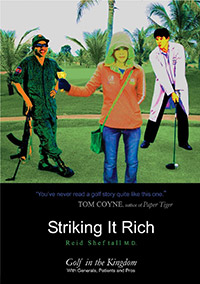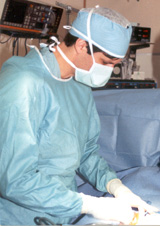 One of the most often-touted explanations for the appeal of golf is that we play the same game, on the same courses, under the same rules, as the greatest players in the world. Is it any surprise, then, that so many of us entertain Walter Mitty-esque fantasies about turning pro? Come on, admit it, if you’ve piped a drive down the middle, followed it up with a pured iron and one putt, you’ve probably allowed yourself to wonder and fantasize, “What if…”
One of the most often-touted explanations for the appeal of golf is that we play the same game, on the same courses, under the same rules, as the greatest players in the world. Is it any surprise, then, that so many of us entertain Walter Mitty-esque fantasies about turning pro? Come on, admit it, if you’ve piped a drive down the middle, followed it up with a pured iron and one putt, you’ve probably allowed yourself to wonder and fantasize, “What if…”
Truth is, most of us are about as likely to see tour action as we are to see, well, Gisele Bündchen action, but every once in a while, a real-life Walter Mitty shows up on the radar. Such is the central theme of Reid Sheftall’s Striking it Rich: Golf in the Kingdom, with Generals, Patients, and Pros. The book will prove entertaining reading for just about any golf-obsessed Sand Trap reader, and might just teach you a thing or two about the game you love most.
There are so many things both fascinating and puzzling about Striking it Rich it’s tough to know where to start. The author, Reid Sheftall, is an American-born, expatriate surgeon who, after completing his medical training in the U.S., emigrated to Cambodia where he has a thriving medical practice at the American Medical Center in Phnom Penh. In the preface, we learn that Sheftall was a talented, promising junior golfer, who left the game due to waning interest and a temper ill-suited for the game.
Visiting family in Florida over the Christmas holiday, Sheftall plays a round at the TPC Sawgrass with his brother and Mark McCumber, a high school teammate of Sheftall’s brother. Encouraged by compliments from both McCumber and Paul Azinger – even more impressive when you consider that at the time of the Sawgrass round, Sheftall had only been playing a few months, following an over thirty-year hiatus from the game – Sheftall returns to Cambodia to embark on his professional golf odyssey.
As if it weren’t difficult enough to try a second career as a touring professional at an age when most of us begin to feel our bodies slowed by the inertia of middle age, Sheftall takes on the task under what are literally third-world conditions. Playing on worse-than-muni golf courses and in a sweltering climate where most of might just decide to stay inside and watch baseball games, Sheftall honed his skill in big money games with an intimidating cadre of high-ranking Cambodian military men.
Practicing and playing while maintaining a busy surgical practice, Sheftall moves on up to higher level amateur tournaments in Cambodia, and eventually professional events on the southeast Asian tours where he entered via Monday qualifying. The final chapters of the book detail his experience in Q-schools of the Asian and Malaysian PGA Tours. All along the way, Sheftall gives the reader several interesting insights on the modern game (“In the twenty-eight years since I’d left the game, golfers’ bodies had changed as much or more than the equipment…”), professional golf in general, as well as a few tips to help your game.

One such passage was particularly interesting to me. During his year trying to qualify for the pro tour, Sheftall was frequently questioned as to how he was able to compete on the pro tour with very limited practice time – remember, he maintained his full duties as a surgeon while “moonlighting” as a professional golfer. The answers would probably prove useful to all of us. “I keep things very simple… I swing the club the way it feels most natural to me.” On hitting the ball close on short shots, Sheftall says:
I don’t ever try to figure out how far to hit it. I bypass consciousness here and let my brain decide… Just think of the target and swing. Never do anything mechanical or measured. Let your natural athletic grace guide you.
Just as we are most often correct on multiple choice questions when we go with our first instinct, so, I think, would many of us be better off simply using Sheftall’s intuitive approach and just hitting it without all the fuss. This is about as anti-Dave Pelz or Jim McLean as you can get, and I admit it may sound like hollow advice to someone whose swing is more akin to a wildebeest mating ritual than “natural athletic grace.” But if we ever needed encouragement to believe the wisdom of the adage about “paralysis by analysis,” this is it. Coupled with properly realistic expectations (most of us know the score on our level of athletic ability), I am tempted to believe that Dr. Sheftall’s approach will produce better results for the average golfer than anything David Leadbetter or Stan Utley has to offer.
The book follows a somewhat meandering course, alternating the golf chronology with interesting anecdotes from Sheftall’s life. In addition to being a golf prodigy, Sheftall borders on genius with numbers, beating the Vegas casinos with some nifty card counting à la “Rain Man” while a physics student at MIT. The numbers whiz also takes an interesting swipe at the USGA’s handicap and slope systems, a topic always rife for debate in golf circles. We take other detours from golf to learn some not-so-pleasant details of Cambodia’s medical system, and Sheftall’s often poignant experiences both in medicine and his interactions with southeast Asian culture.
In fact, given the nature of some of his medical experiences, I wondered more than once while reading where he summoned the energy to take a stab at pro golf. Most people would probably feel sufficiently happy and fulfilled – if not too exhausted – knowing they are bringing modern medicine to an impoverished, third world nation.
His humanitarian efforts deserve special mention. Sheftall’s American Medical Center is a fully staffed hospital and clinic providing critical medical services to Phnom Penh and surrounding villages.
Sheftall and the staff provide plastic and reconstructive surgery on a pro-bono basis to injured adults and children of limited means. While not taking anything away from the efforts of organizations like the PGA Tour and the USGA in this regard, in Sheftall we have a man, a professional golfer, who truly walks the walk when it comes to charity.
 “Striking it Rich” is indeed a unique story, but in the end left me with more questions than anything else. While the “quest for the Card” aspect of the book is easy enough to latch onto (and Sheftall does, eventually, qualify for the tour), the interspersed vignettes about his private and professional life seemed disjointed and unfinished. This aspect of the book is both detailed and engaging enough to make me want to learn more about, for example, why Sheftall left the U.S., or why he chose plastic surgery instead of something more congruent with his savant-like facility with numbers, yet these subjects are left as blind alleys. Oh yes, and I’d also like to know why we never got a photo of the badminton girl (you’ll have to buy the book to find out what I mean).
“Striking it Rich” is indeed a unique story, but in the end left me with more questions than anything else. While the “quest for the Card” aspect of the book is easy enough to latch onto (and Sheftall does, eventually, qualify for the tour), the interspersed vignettes about his private and professional life seemed disjointed and unfinished. This aspect of the book is both detailed and engaging enough to make me want to learn more about, for example, why Sheftall left the U.S., or why he chose plastic surgery instead of something more congruent with his savant-like facility with numbers, yet these subjects are left as blind alleys. Oh yes, and I’d also like to know why we never got a photo of the badminton girl (you’ll have to buy the book to find out what I mean).
In the end, I believe any avid golfer will enjoy reading “Striking it Rich.” You may not walk away ready to qualify for the Hooters Tour, but you’ll likely come away with a greater appreciation for the game of golf as well as life in modern society. Sheftall’s book can be ordered on his website . Half of all revenue from book sales will be used to fund charitable causes at the American Medical Center in Phnom Penh including Sheftall’s OperationKids organization.

I’ll bite…sounds good.
Nice review.
I have read the book. Enjoyed it immensely. There is a certain charm of people daring to pursue their dreams in mid-life despite all the baggage that maturity supposedly brings.
Good Luck Dr.Reid.
Nice thoughts about the short game. I watched an old Tiger clinic on YouTube the other day, and he said something like, “I wouldn’t know how to make a ’15-foot stroke’ with a putter.” He said his dad taught him to look at the hole, take a mental picture, and hit the ball to the picture. No walking off the distance or calculating backswing.
It’s like basketball shooters — do they walk off the distance and then decide how far to cock the hand back? No, they just look at the rim and launch the ball. Good putting and chipping is the product of hitting thousands and thousands of balls for years and years. You just have to know how hard to hit the ball, out of what type of lie.
I’m reading the book as well. It’s worth reading.
Wow, that’s quite a story!
I may have to pick this book up…amazing stuff. Especially “moonlighting” as a pro golfer AND being a surgeon. Now, that’s a packed schedule.
New to the site. Saw your review when looking up the author on google. Nice take on this book but you left out one thing; the humor. Very funny book. Not slapstick but sublte dry, intelligent humor. I found myself smiling under my breath when he got himself into some of those situations and when I couldn’t contain myself, burst out laughing. Also, I hope readers appreciate this book as ideal for teenagers to young adults. I am having my teenage son and daughter read it. It will broaden their knowledge of the world and the people in it and make them appreciate where they are, all the while inspiring them to dream big dreams and make the most of their lives and the talents God gave them. If there was a book of the year prize in golf, this one should win it. An inspiring work of genius.
Ken: Great point. It’s self-deprecating, dry humor and is very well done. Thanks for reading. JP
A real-life Walter Mitty? Quite the opposite! Walter Mitty was a nondescript, hen-pecked man who fantasized about a more exciting life to escape his banal existence and overbearing wife. He was none of the things he imagined himself to be. I’ve read the book and I met the author last week at the golf course here. We played eighteen holes together.
The doctor didn’t imagine scoring an 800 and getting a physics from MIT; he did it. He didn’t imagine making money counting cards in the casino; he did it. He didn’t imagine changing the lives of the burned children as a plastic surgeon; he did that too. And in his late 40’s he didn’t just fantasize about qualifying for and playing the pro golf tour , he got his card and plays whenever he can. These things may be easy to fantasize about, but not so easy to do.
I foolishly played along side him from the blue tees at the Cambodia Golf and CC that day and with the help of watching his easy rhythm, played as well as I can play as a seven handicapper. I shot 87. Meanwhile, the doctor shot 70. Never played with anyone like that in my life. He didn’t hit the ball as far as I thought he would but every one was straight down the sprinkler line. 275 maybe.He was in 3 bunkers (two on par fives in two) and each time he tossed one up there two feet from the hole and tapped it in. Three birdies and one bogey. Looked too easy. On the thirteenth hole he stopped our game for twenty minutes and showed me how to hit bunker shots. I had to ask…
Over a beer, he told me about his book. When we left, he went out to his car and got one for me. He said he hadn’t sold too many. Was glad he wrote it anyway.
Well CK, you are definitely right! I stand corrected. I suppose I used Mitty a bit sloppily, but the general idea of a man toiling away at “real life” and suddenly living a dream captures both Mitty and Sheftall, I think.
Great experience you had with Reid. I hope I get to play with the doctor one day.
Fabulous book and fascinating guy. Not only a great read, but a great gift for any golfers you know!
Just bought the book & met up with Reid by chance, so far a very interesting guy, will get stuck into the book and pass my comments on.
J.P, you wondered why plastic surgery vs something more numbers related…well you would have to ask Reid, but I suspect that it his way of incorporating his artistic talent into his work and giving back to others at the same time. I saw some of his drawings when we were at school together and he is quite talented. A rare multi-talented person with a big heart and great sense of humor. By the way, he flew in from interning in med school to my bachelor party, showed up in loafers with no socks and played in his dress shoes not having played I think since High School and beat everyone there that day, shooting an 81 if I remember correctly. He then flew back that night because he was on the next shift.
NO KEITH!
IT WAS A 77.
OH GOD!
My sincerest apologies about the score, Reid… let’s chalk it up to my memory and not being in your foursome, but you definitely beat the pants off the crowd. I hope you are well.
I am a bogey golfer, American and retired engineer living in Cambodia. I throughly enjoyed Doctor Reed’s book. The author gave the reader enough detail to use our own imagination and I found myself rooting for him. Great book